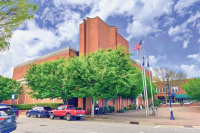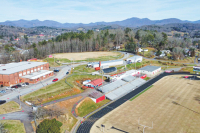Global warming imperils Golden-winged warbler
 The steady decline of the Golden-winged Warbler on the Southern Appalachian landscape is a trend that not only threatens the future of the bird in Western North Carolina but also puts in peril the species as whole.
The steady decline of the Golden-winged Warbler on the Southern Appalachian landscape is a trend that not only threatens the future of the bird in Western North Carolina but also puts in peril the species as whole.
During the past century, it has experienced one of the most precipitous population falls of nearly any other songbird species. Brought on by habitat loss and interbreeding with a more dominant species of warbler, less than 500,000 exist in the United States.
Most are found in the northern Midwest, but there are 2,000 or so hold-outs here in the high elevations of the Southern Appalachian mountains. It may seem like a drop in the bucket, but the small group of Golden-winged warblers found in WNC — at the southernmost extent of the species’ range — are more significant than the numbers alone would indicate, however.
“We want to preserve these birds in the Appalachians as kind of a safety net,” said Curtis Smalling, director of land bird conservation for Audubon North Carolina and based out of Boone. “If things change, they’ll be able to go upslope.”
In other words, if the climate keeps warming, the Golden-winged warbler could find much of its current habitat elsewhere become inhospitable. But here in the mountains, it could seek refuge by moving higher up the mountainside.
Related Items
Found predominantly between the elevations of 3,000 and 4,500 feet, the Golden-winged Warblers is known as “Canadian throwback,” a nickname given to species that took hold in Appalachians eons ago when its climate resembled that of Canada. Now, they are confined to high-elevation islands, seeking refuge in pockets that still have those cooler climes.
The mountains, Smalling said, give the bird distinct advantages to overcoming threats the species is facing elsewhere.
In recent years, the winter breeding ground of the Golden-winged Warbler has shifted both north and west across the U.S. States, attributed to a warming climate and loss of its preferred shrubby habitat.
However, faced with a wall of coniferous forest to the north — which is not an ideal habitat for the bird — it has pushed west on a course that brings it in contact with another non-ideal habitat: the Great Plains.
“They’re going to hit prairie to the west and boreal forest to the north,” Smalling said. “They’re going to run out of habitat.”
The mountains are a potential safe-haven for another important reason, however — the elevation seems to be a deterrent against other more dominant species.
As the Golden-winged warbler fled north and west, its cousin the Blue-winged Warbler has been close on its tail, following it into states like Minnesota and Wisconsin and competing for resources. The two warbler species are also known to intermingle, but the result is usually more Blue-winged than Golden-winged. In some areas, such as Connecticut, the Blue-winged Warbler has breed its counterpart out of existence, and the offspring can be born with its song, its colors and other attributes.
While rapidly encroaching on the habitat of the Golden-winged Warbler in other parts of the country, the Blue-winged Warbler seems to be deterred by elevations higher than 3,000 feet. In WNC, about 15 percent of the Golden-winged Warblers have traces of Blue-winged Warbler in their DNA already, Smalling said.
A choosy bird
Scientists, bird enthusiasts and environmentalists have been working hard to preserve and recreate the Golden-winged habitat in the high Southern Appalachians.
The biggest challenge is that it’s a choosy bird.
The Golden-winged Warbler prefers young, immature forests and shrub lands above 3,000 or so feet. Anything else, and the bird will probably not nest.
“They’re really kind of picky,” said Patrick Farrell, a biologist with the N.C. Wildlife Commission.
The birds thrived in the Southern Appalachians in the era following clear-cut logging, when mountaintops were stripped and barren expanses dotted with shrubs and sparse trees were left. Their reign continued through the years when agriculture dominated the landscape with open fields and pastures.
But as development and forests grow up over historic pastures, the bird’s land is being gobbled up.
Farrell works under contract with the U.S. Department of Agriculture to recruit private landowners in WNC to maintain Golden-winged Warbler habitat. That task is not simple: the list of criteria is long, and many don’t make the cut. Factors like elevation, size of the property, type of vegetation and the property’s proximity to other nesting Golden-winged Warblers and large housing developments are all taken into consideration.
But, if a landowner’s property fits the bill, and they are willing to participate, they get financial assistance to help with the upkeep the open shrub habitat the warblers like. Burning, tree-cutting and grazing are all techniques used to keep the right blend of open space and trees.
Currently, Farrell is working with property owners in WNC, including Jackson County and Haywood County, to create Golden-winged Warbler habitat.
As is the case with a property owner in Jackson County, sometimes it’s a crap shoot: her property might not have any nesting pairs now but the hope is that if a nice habitat is built, they will one day come. In other cases, the birds have been nesting in an area for a while but encroaching forests or development threaten to push them off.
“Sometimes we will find them where they are just holding on,” Farrell said.
The USDA took an interest in the bird a few years ago after it was deemed one of several “species of concern” through the agency’s wildlife habitat incentive program, an initiative to defray the costs of habitat creation for property owners. The hope is to save the Golden-winged Warbler, and other animals like it, before the situation is dire.
“The philosophy is to recover that habitat, whatever it is, before they become endangered or threatened,” Farrell said.
When the program was started three years ago, Farrell was switched from his post working on habitat for the Bobwhite Quail to the warbler. As for its success with the warbler, he said it was promising but early in the game.
“This year is my best year for recruiting land owners,” Farrell said. “We’re doing work now, but it’s too early to tell.”
Two-sided coin
On public lands, such as the Nantahala and Pisgah national forests, warbler habitat can be controversial. Since the warbler thrives in immature forests and shrub lands, logging interests have elevated the Golden-winged warbler to golden-child status, using it as an excuse to log in the name of helping create habitat for the bird.
But logging to create habitat for the warbler could hurt other equally important bird species that prefer mature forests.
As Smalling pointed out, the Audubon Society also has a long list of high-priority forest species it would like to help as well. And the pickiness of the warbler can mean that a small, well-chosen plot of land can oftentimes be better suited for nesting than vast expanses at the wrong elevation or out of their migratory flight path.
“It’s a balancing act,” Smalling said. “We don’t want the National Forest Service cutting trees in the name of Golden-winged Warblers while ignoring other birds. We don’t need 100,000 acres of new habitat that’s not occupied.”









